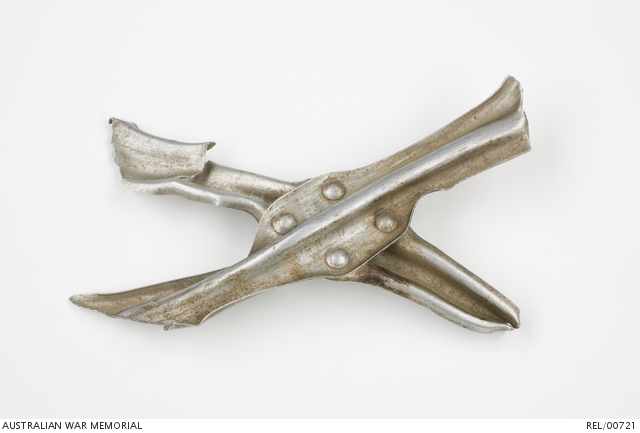| Place | Europe: United Kingdom, England |
|---|---|
| Accession Number | REL/00721 |
| Collection type | Heraldry |
| Object type | Heraldry |
| Physical description | Aluminium |
| Maker |
Luftschiffbau Zeppelin |
| Place made | Germany |
| Date made | 1916 |
| Conflict |
First World War, 1914-1918 |
Fragment of metal from Zeppelin L31 : A H Gold

Cross shaped section of duraluminium (an aluminium alloy) framework from a German Zeppelin. The two pieces of framework are held together by four rivets. Three ends appear to have been torn form the framework, while the fourth is compressed together, indicating it may have been cut. There is a tear at the end of one piece of the cross pieces.
This piece of Zeppelin L31 was collected by A H Gold while recovering in hospital at Chigwell in London after being wounded at Thiepval in September 1916. The identity of Mr Gold has not been determined and he may not have served in the Australian Forces. The L31 was shot down on 1 October 1916 by Second Lieutenant Wulstan Tempest, 39 Squadron, Royal Flying Corps. The crew were all killed, either by jumping from the flaming Zeppelin or burning to death. They were originally buried at Potters Bar, where the Zeppelin had been shot down, but their remains were moved to Cannock Chase in Staffordshire in the 1960s. Pieces of airships, especially Zeppelins, were a very popular souvenir in England during the First World War. People travelled long distances to view the crash sites and purchase, or scavenge for, pieces of the wreckages. At the site of the crash of SL11 pieces of the airship were sold by the Red Cross to raise money for wounded soldiers. The souvenirs proved so popular to visitors of the site, at Cuffley, that the Red Cross ran out of pieces of the SL11 and began selling pieces of the L31. While some parts remained as they were found, other pieces of airships were turned items such as of jewellery and other small souvenirs.